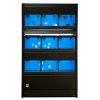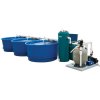I'm setting up a dedicated fishroom in a basement room that will have two 500 gallon round tanks plumbed to an adjacent filter room. I have room to hook a rack system up across from the round tanks to house eggs and grow out. Ideally, I'd like to have this plumbed to the filter room as well not only from a maintenance standpoint, but also for water quality. The room has two doors for whatever reason, but they are both in good spots with the basement layout, so I don't really want to block one off to run plumbing. I also don't want to run any pipes along the floor. If I could run all the plumbing overhead along the ceiling, I could easily do it.
Has anyone hooked multiple tanks together using a common header tank as a "junction box?" Basically the filter room would also be on a loop to the header tank continually circulating, and the rack system would feed into the header tank and gravity feed back to the rack system. Plumbing something like that makes sense to me, what I can't figure out is how to make it work and not flood if one pump is turned off for whatever reason. This may be impossible from a physics standpoint, but I thought I'd throw out the idea anyway. I will probably have to run a separate filter, but wanted to first see if anyone has hooked multiple tanks together with all the plumbing on the ceiling?
Here is a crude drawing to show what I'm talking about, the header tank idea is in red:


Has anyone hooked multiple tanks together using a common header tank as a "junction box?" Basically the filter room would also be on a loop to the header tank continually circulating, and the rack system would feed into the header tank and gravity feed back to the rack system. Plumbing something like that makes sense to me, what I can't figure out is how to make it work and not flood if one pump is turned off for whatever reason. This may be impossible from a physics standpoint, but I thought I'd throw out the idea anyway. I will probably have to run a separate filter, but wanted to first see if anyone has hooked multiple tanks together with all the plumbing on the ceiling?
Here is a crude drawing to show what I'm talking about, the header tank idea is in red:












